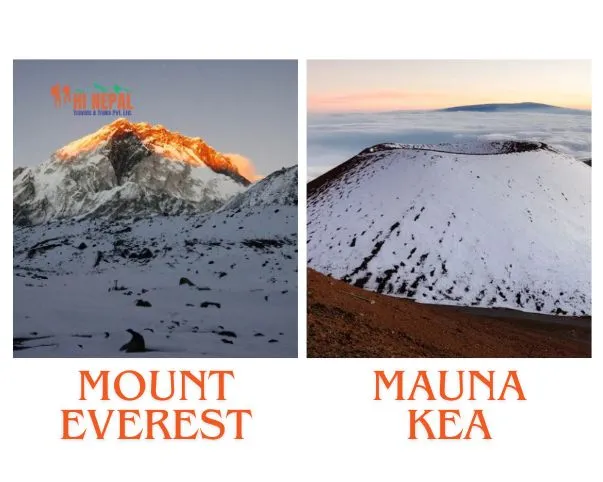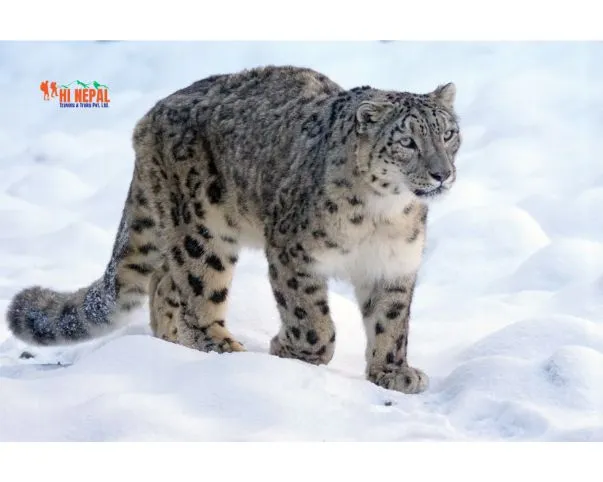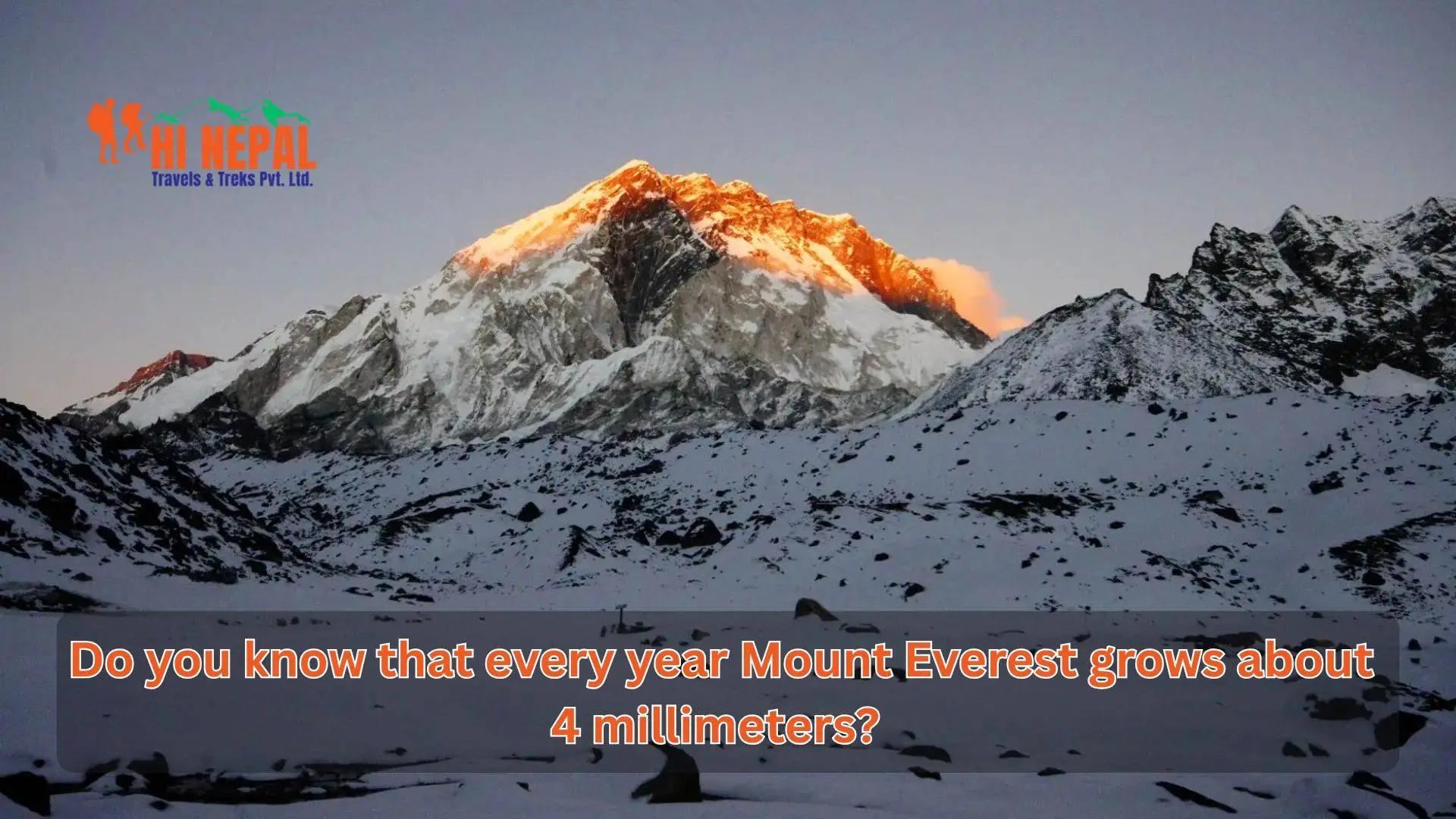Hello Travel Learners!
Want to know something new? Why not some of the surprising facts about Mount Everest?
We all know Mount Everest for a common factor, that this legendary peak is the tallest mountain in the world, standing tall at an altitude of 8,848.86 m (29,031.69 feet). But, do you know, from the base of the ocean floor, it actually is Mauna Kea, which is taller than Mount Himalaya. Here are 10 mind-blowing facts that you may have no idea of:
Is Mount Everest the Tallest Mountain?

When we talk about the tallest mountain in terms of height above sea level, Mount Everest takes the crown. However, the lesser-known Mauna Kea in Hawaii surpasses Everest when considering the base-to-summit height. Rising from the ocean floor, Mauna Kea measures over 33,000 feet, making it a true giant of the Earth.
The reason Mauna Kea is taller when measured from base to summit is due to its unique geological formation. Unlike Everest, which rests on the continental crust, Mauna Kea emerges from the oceanic crust, resulting in a massive underwater base. This anomaly highlights the diverse ways nature shapes our planet.
Climbing Mauna Kea may not have the same allure as Everest, but it presents its own challenges. The ascent from the ocean floor to its peak involves traversing underwater landscapes, requiring skills in both diving and climbing. This duality adds a unique twist to the concept of mountain climbing.
Different Heights of Mount Everest
One of the interesting facts about Mount Everest is that Nepal considers Mount Everest’s height to be 29,032 feet (8,848 meters). This measurement was established using the Survey of Nepal in collaboration with international experts. The Nepalese view emphasizes precision and cultural significance, as Everest is a national symbol.
China’s calculation of Everest’s height is slightly less, at 29,029 feet (8,848 meters). This discrepancy arises from different measurement techniques and starting points. The Chinese approach involves advanced surveying technology, reflecting their commitment to scientific accuracy.
Efforts have been made to reconcile these differences, leading to joint surveys and collaborative studies. These efforts highlight the importance of international cooperation in understanding natural phenomena. The differing measurements also underscore the complexity of accurately measuring such a monumental peak.
Is Mount Everest Still Growing?
One of the unbelievable facts about Mount Everest is that it is still growing. The movement of the Indian and Eurasian tectonic plates causes the Himalayas to rise approximately 4 millimeters every year. This ongoing geological activity keeps Everest in a state of perpetual change.
The gradual growth of Everest Himalaya has implications for climbers and researchers alike. As the mountain rises, routes may subtly shift, and new challenges can emerge. Understanding these changes is crucial for ensuring safe and successful ascents.
Everest serves as a natural laboratory for scientists studying tectonic activity. Research conducted on the mountain provides valuable insights into Earth’s dynamic processes. This growing giant offers a unique opportunity to witness geology in action.
What are the Different Names of Mount Everest?
Before it was famously known as Mount Everest, the peak was called Sagarmatha in Nepal, meaning “Goddess of the Sky.” This name reflects the mountain’s spiritual significance in Nepalese culture. Sagarmatha is more than just a mountain; it’s a revered deity.
In Tibet, Everest Himalaya is called Chomolungma, which translates to “Mother Goddess of the Universe.” This name highlights the mountain’s prominence in Tibetan spirituality and mythology. Chomolungma is considered a sacred place, imbued with divine presence.
The name Mount Everest was bestowed in honor of Sir George Everest, a British surveyor-general of India. This naming reflects the colonial history and exploration era during which the mountain was first surveyed. The decision to name the peak after Sir George was a testament to his contributions to cartography.
Who was the First Person to Climb Mount Everest?

The first successful climbers to reach the summit of the tallest mountain in the world, Mount Everest, were Sir Edmund Hillary from New Zealand and Tenzing Norgay, a Sherpa of Nepal, on May 29, 1953. Their historic climb is celebrated as a monumental achievement in mountaineering history. It marked the beginning of modern exploration on Everest.
Tenzing Norgay’s role in the first ascent highlights the invaluable contributions of the Sherpa community. Sherpas are renowned for their expertise and resilience in high-altitude environments. Their support and knowledge have been crucial in numerous successful expeditions.
The success of Hillary and Norgay continues to inspire climbers around the world. Their achievement is a testament to human determination and the spirit of adventure. The legacy of their climb lives on in the countless expeditions that follow in their footsteps.
Death on Mount Everest
Climbing Mount Everest is no small feat, and it comes with significant risks. Over 300 climbers have tragically lost their lives on Everest since 1953. The dangers include avalanches, falls, altitude sickness, and exposure to extreme weather conditions.
The harsh conditions on Everest Himalaya test the limits of human endurance. Climbers face freezing temperatures, fierce winds, and unpredictable weather. These factors contribute to the high mortality rate on the mountain.
Each tragic loss on Everest serves as a sobering reminder of the mountain’s dangers. The climbing community continually learns from these experiences to improve safety measures. Innovations in gear, training, and technology aim to reduce risks for future climbers.
Firsts to Climb Mount Everest
First Women Climb Mount Everest
Junko Tabei from Japan became the first woman to reach the summit of Mount Everest on May 16, 1975. Her achievement was not only a personal triumph but also a monumental milestone in mountaineering history. Tabei’s ascent challenged gender norms and inspired women worldwide.
Tabei’s journey to the summit was fraught with challenges, both physical and societal. She faced skepticism and limited opportunities as a female climber. Her success demonstrated that passion and perseverance know no gender boundaries.
Junko Tabei’s legacy continues to empower women in mountaineering and beyond. Her story encourages women to pursue their dreams and break through barriers. Tabei’s impact is felt in the growing number of female climbers taking on Everest and other peaks.
Youngest Person to Climb Mount Everest
Jordan Romero, an American, was just 13 years old when he reached the summit of Everest in 2010. His record-setting ascent captured the world’s attention and sparked debates about age and safety in mountaineering. Romero’s climb showcased the potential of youthful ambition.
Oldest Person to Climb Mount Everest
Yuichiro Miura, an 80-year-old Japanese alpinist, became the oldest person to summit Everest in 2013. Miura’s achievement exemplifies the idea that age is just a number. His climb was a testament to lifelong passion and the enduring spirit of adventure.
The feats of Romero and Miura raise important questions about age limits in high-altitude climbing. While their achievements are celebrated, they also prompt discussions on the physical and ethical considerations of extreme expeditions. Balancing ambition with safety remains a key concern in the climbing community.
Flora and Fauna on Mount Everest

Despite its harsh conditions, Everest Himalaya hosts some unique plant and animal life. Snow leopards, elusive and endangered, roam the lower regions of the mountain. These majestic creatures are a symbol of the mountain’s biodiversity.
The flora on Everest includes rare species like the Himalayan blue poppy. This delicate flower blooms in the mountain’s surrounding areas, adding a splash of color to the rugged landscape. The plant life on Everest is a testament to nature’s adaptability.
Efforts are underway to protect the unique flora and fauna of the Everest region. Conservation initiatives aim to preserve the mountain’s ecological balance and prevent habitat loss. These efforts highlight the importance of safeguarding Everest’s natural heritage.
Cost to Climb the Tallest Mountain in the World, Mount Everest
Attempting to climb Mount Everest is not just physically challenging but also financially demanding. The standard supported climb cost of Mount Everest ranges from $28,000 to $85,000. These expenses cover permits, gear, guides, and other logistical needs.
For those seeking a more comfortable experience, luxury expeditions can cost upwards of $100,000. These high-end climbs offer additional amenities and personalized services. The luxury option provides an entirely different perspective on the Everest experience.
The financial aspect of climbing Everest Himalaya also impacts local communities. The influx of climbers supports the economy of the region, providing jobs and income for Sherpas and local businesses. Balancing economic benefits with environmental and cultural preservation is an ongoing challenge.
The Unpredictable Weather of Mount Everest
The weather on Everest is notoriously unpredictable. Temperatures can plummet to -76°F (-60°C) in winter, while the jet stream brings winds exceeding 200 mph (322 kph). These extreme conditions make climbing Everest a daunting endeavor.
Climbers must be well-prepared to face Everest’s harsh weather. Specialized gear and training are essential for enduring the cold and wind. Understanding weather patterns and timing ascents carefully is crucial for safety.
The weather on Everest significantly influences the success of expeditions. Sudden storms and temperature drops can halt progress and endanger climbers. Navigating these challenges requires skill, experience, and a deep respect for nature’s power.
Final Thoughts
Mount Everest is more than just the tallest mountain in the world; it’s a place rich in history, adventure, and mystery. From its growth and naming origins to the courageous climbers who have conquered it, Everest continues to captivate the world. Whether you’re planning your own expedition or simply dreaming of the heights, these facts showcase the awe-inspiring nature of this incredible peak.
As we continue to explore and understand the facts about Mount Everest, one thing is certain: Mount Everest will always hold a special place in the hearts of adventurers and explorers alike. So, next time you think about the world’s highest peak, remember these surprising facts and share the wonder of Everest with others!
FAQs
1. Where is Mount Everest?
The world’s tallest mountain, the legendary Mount Everest, is situated on the border of Nepal and China. The south face of Everest is located in Nepal, whereas the north face of Mount Everest is situated in Tibet, a state of China.
2. How tall is Mount Everest?
The height of the tallest mountain in the world, the legendary Mount Everest, is 8,848,86 m (29,031.69 feet) above sea level. One of the unbelievable facts about Mount Everest is that Everest grows about 4 millimeters every year.
3.How old is Mount Everest?
According to multiple scientific studies, the geological age of Mount Everest is approximately 50 to 60 million years. This iconic mountain was formed when the Indian and Eurasian Tectonic plates collided with each other, pushing the land high above the surface, resulting in the formation of the tallest mountain in the world.
4. How cold is Mount Everest?
As the tallest mountain in the world, Mount Everest, is known for its extreme climate. The summit of Everest faces the maximum drop in temperature, with almost up as -60°C (-76°F). Even in the Peak climbing season, the temperature can drop to -20°C (-4°F).
5. Is Everest a volcano?
No, Everest is not a volcano, as this iconic peak was formed more than 50 million years ago, when the Indian and Eurasian Tectonic plates collided with each other.
6. How hard is it to climb Everest?
One of the adventurous yet rewarding adventures, climbing Mount Everest, is not an easy job to do. To successfully climb Mount Everest, not only physically, but you have to be prepared mentally and financially as well. A successful Mount Everest expedition requires dedication and passion, as this 7 to 8-week adventure is one of the toughest.
7. What is the height of Everest Base Camp?
Situated at the feet of Mount Everest, the height of the Everest Base Camp elevation is 5,364 meters (17598.43 feet) above sea level.
8. What is the highest mountain before Mount Everest was discovered?
Mount Kanchenjunga, the third-tallest mountain in the world, standing tall at an altitude of 8,586 meters (28,169 feet), was known as the world’s tallest mountain before Mount Everest.
